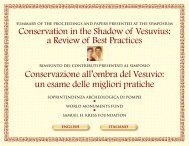2008 Annual Report - World Monuments Fund
2008 Annual Report - World Monuments Fund
2008 Annual Report - World Monuments Fund
You also want an ePaper? Increase the reach of your titles
YUMPU automatically turns print PDFs into web optimized ePapers that Google loves.
various loCations<br />
Jewish Heritage Program<br />
<strong>World</strong> <strong>Monuments</strong> <strong>Fund</strong>’s Jewish Heritage<br />
Program ( JHP) addresses threats to Jewish<br />
cultural heritage around the world, from India<br />
to Greece, Hungary, France, Poland, Morocco,<br />
and Lithuania. Sites date from the 15th to the<br />
early 20th century. Since the JHP was launched 20 years ago, its<br />
focus has evolved from documenting these sites and attending<br />
to their conservation needs to preserving their cultural legacy by<br />
encompassing efforts that strengthen communities concerned with<br />
long-term stewardship. To this end, we have been working with<br />
the American Jewish Joint Distribution Committee; through their<br />
international network, we can expand the reach of the JHP.<br />
This year, WMF announced four new Jewish Heritage grants in<br />
post-Soviet Eastern Europe:<br />
Founded in 1803, Volozhin Yeshiva in Belarus was a model for<br />
the yeshiva system in eastern Europe. A WMF-funded conditions<br />
assessment will help determine next steps, with the aim of assuring<br />
the continued recognition of important Jewish contributions to the<br />
cultural history of Belarus.<br />
Subotica Synagogue in Serbia, built in 1902, is considered one of<br />
the finest examples of Art Nouveau architecture in Europe. WMF<br />
has been involved with the conservation of Subotica Synagogue<br />
since the 1990s; this latest grant supports work on the façade. The<br />
synagogue will reopen as a memorial and cultural center.<br />
Zamość Renaissance Synagogue in Poland, dating from the first<br />
half of the 17th century, was active until <strong>World</strong> War II, when the<br />
Nazis used it as a carpentry workshop. The architectural character<br />
of the building remains largely intact; WMF is supporting urgent<br />
stabilization measures so the building can be reopened as a museum<br />
and community center.<br />
Vilnius Choral Synagogue in Lithuania is the only synagogue in<br />
Vilnius still functioning. Opened on Rosh Hashanah in 1903,<br />
it survived <strong>World</strong> War II by being converted into a store. Today,<br />
a great deal of work is required to keep the building structurally<br />
sound: roof repair, strengthening and painting the walls, restoring<br />
the façade, and renovating the benches.<br />
Volozhin Yeshiva<br />
Subotica Synagogue<br />
Zamo´sć Renaissance Synagogue<br />
Vilnius Choral Synagogue<br />
27
















